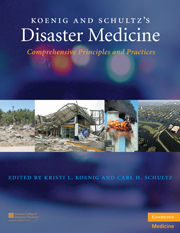Book contents
- Frontmatter
- Contents
- List of Contributors
- Contributor Biographies
- Foreword
- Preface
- Acknowledgments
- PART I CONCEPTUAL FRAMEWORK AND STRATEGIC OVERVIEW
- PART II OPERATIONAL ISSUES
- 9 Public Health and Emergency Management Systems
- 10 Legislative Authorities and Regulatory Issues
- 11 Syndromic Surveillance
- 12 Triage
- 13 Personal Protective Equipment
- 14 Decontamination
- 15 Quarantine
- 16 Mass Dispensing of Antibiotics and Vaccines
- 17 Management of Mass Gatherings
- 18 Transportation Disasters
- 19 Emergency Medical Services Scene Management
- 20 Healthcare Facility Disaster Management
- 21 Mass Fatality Management
- 22 Crisis and Emergency Risk Communication
- 23 Telemedicine and Telehealth Role in Public Health Emergencies
- 24 Complex Public Health Emergencies
- 25 Patient Identification and Tracking
- PART III CLINICAL MANAGEMENT
- Index
- Plate section
- References
14 - Decontamination
from PART II - OPERATIONAL ISSUES
Published online by Cambridge University Press: 05 August 2011
- Frontmatter
- Contents
- List of Contributors
- Contributor Biographies
- Foreword
- Preface
- Acknowledgments
- PART I CONCEPTUAL FRAMEWORK AND STRATEGIC OVERVIEW
- PART II OPERATIONAL ISSUES
- 9 Public Health and Emergency Management Systems
- 10 Legislative Authorities and Regulatory Issues
- 11 Syndromic Surveillance
- 12 Triage
- 13 Personal Protective Equipment
- 14 Decontamination
- 15 Quarantine
- 16 Mass Dispensing of Antibiotics and Vaccines
- 17 Management of Mass Gatherings
- 18 Transportation Disasters
- 19 Emergency Medical Services Scene Management
- 20 Healthcare Facility Disaster Management
- 21 Mass Fatality Management
- 22 Crisis and Emergency Risk Communication
- 23 Telemedicine and Telehealth Role in Public Health Emergencies
- 24 Complex Public Health Emergencies
- 25 Patient Identification and Tracking
- PART III CLINICAL MANAGEMENT
- Index
- Plate section
- References
Summary
DEFINITION OF DECONTAMINATION
Decontamination is the reduction or removal of contaminating material by a dilutional, chemical, and/or mechanical process. It should be performed whenever there is likelihood of contamination or risk of secondary exposure.
In general, decontamination is accomplished by removing the victim's clothing followed by copiously rinsing the patient with tepid water. Gently scrubbing the skin with soap and a soft brush removes any remaining fat-soluble chemicals and solid materials. Eliminating contaminants from a victim's skin and clothing is important for two reasons. It reduces the risk for further absorption or inhalation and the subsequent toxicity caused by the offending agent. In addition, decontamination helps to prevent others from becoming secondarily exposed or contaminated.
The degree of decontamination performed depends on the situation. In general, removing and bagging the victim's clothing eliminates 60%–90% of the contaminants (depending on the extent of clothing worn at the time of exposure) and minimizes the risk of spreading the toxic agent to others. This initial step in the decontamination process should always be performed regardless of the agent or setting. Depending on the availability of resources, the victim's symptomatology, and the availability of resources, additional decontamination measures may be necessary.
In this chapter, discussion will be limited to the decontamination of humans after exposure to a hazardous substance. Issues related to regulatory standards, personal protective equipment (PPE), and training are addressed elsewhere.
Keywords
- Type
- Chapter
- Information
- Koenig and Schultz's Disaster MedicineComprehensive Principles and Practices, pp. 195 - 202Publisher: Cambridge University PressPrint publication year: 2009



